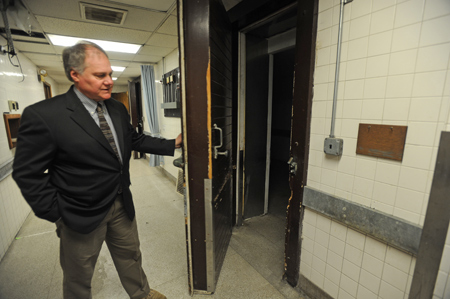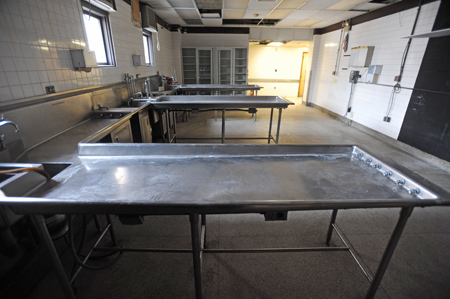
Preservationists Praise Rehab Plan for Old Morgue
By Craig Smith, PITTSBURGH TRIBUNE-REVIEW
Friday, March 11, 2011
http://www.pittsburghlive.com/x/pittsburghtrib/lifestyles/s_726879.html

Sam Taylor, principal architect/building manager for Allegheny County department of public works, gives a tour of the old Allegheny County Morgue before it undergoes a $4 million renovation. James Knox | Tribune-Review
As a 14-year-old growing up in Oakland, Sam Taylor went to the Allegheny County Morgue at the urging of his friends to see the bodies on display.
It was a tradition for generations of Pittsburgh teens, he said. Some even took their prom dates.
“When you’re 14, you think you’re invincible,” said Taylor, 59, of Mt. Lebanon. “There was this yellowish light, and the bodies were kind of leaned back.”
Taylor, the county’s principal architect/building manager, is overseeing a $4 million renovation of the former morgue. The building, completed in 1903, was moved the length of a football field in 1929 to make way for the County Office Building.
Allegheny County expects to seek bids for demolition inside the building in late April or early May. That will create an additional 30,000 square feet of office space, while preserving many of the building’s unique features. The plan is to reuse transoms, stair railings and courtroom banisters, Taylor said.

The autopsy room inside the old Allegheny County Morgue will be transformed into a new use. James Knox | Tribune-Review
A $900,000 project that included installing a terra cotta roof and masonry work was completed in 2006.
Officials haven’t determined who will use the space.
“We have a number of departments using leased space, including the Law Department and Economic Development,” said county spokesman Kevin Evanto.
Architect Paul Apostolou, who made a trip to the morgue when he was in high school, said a big part of the project will be undoing the “sledgehammer and hacksaw” approach to renovations over the years.
Preservationists praise the effort.
“I think they are trying to treat it very well for a building that no longer suits its original purpose because of modern technology,” said Arthur Ziegler, president of Pittsburgh History & Landmarks Foundation. “It’s a notable building in the government complex.”
The city designated the Frederick Osterling-designed building as a Pittsburgh landmark in 2002. Osterling, one of Pittsburgh’s premier architects, designed the county jail expansion of 1904 and Union Arcade (1915-17), which became Two Mellon Bank.

The "chapel" of the vacant old Allegheny County Morgue Friday was a place of prayer in a somber place. James Knox | Tribune-Review
The morgue building was designed to visually match the jail and courthouse, but by 1929, county government needed more space, according to a history of the building compiled by History & Landmarks. Officials decided a consolidated office building on Ross Street between Forbes and Fourth avenues would be the most efficient. That forced them to relocate the morgue.
The move was an enormous undertaking that took about three months. Work inside the building by the coroner and his staff continued without interruption, though. Temporary gas, water and sewer lines were connected and maintained on a 24-hour basis.
Huge timberwork and steel rails were used to move the building, which had to be lifted to the same height at the same moment. That ticklish maneuver was carried out by 100 men from a Balkan tribe — specialists in moving buildings from the “old country.”
They manned screw jacks that they gave a quarter turn every time a whistle sounded, until the three-story building was 27 feet in the air. It then was moved onto a system of beams designed by Kress-Oravetz Co. and slowly, laboriously pulled by cable to the foundation at 542 Fourth Ave.
Once there, Taylor said, they had to “shoehorn” the building between two structures.
In 2005, voters approved a referendum that eliminated the coroner as a row office, returning it to its early roots as an appointed position, now called medical examiner. The medical examiner’s office relocated in 2009 to a building in the Strip District.
